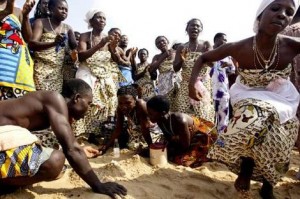Fon is spoken by over half the people of Benin and it is the mother tongue of voodoo. In Fon the root word for voodoo is vodoun that means spirit or god. Voodoo had its origins over 350 years ago in West Africa. In fact Allada, a small town in Benin, is often called the ‘cradle of voodoo’. In 1996, January 10th became National Voodoo Day in honor of its followers that make up 65% of Benin population.
The religion Vodoun was a by-product of the slave trade. This Yoruban religion was carried to Haiti in a slave trade from Dahomey,  which is currently called Benin. Once in Haiti, the slaves were forced to adopt Catholicism. Desiring to keep their native practices, the slaves continued to perform their rituals in private. They transposed Catholic saints onto the tribal deities, called loa, to please their owners. Instead of hindering the faith of the slaves, the incorporation of the saints added something new to their religion. Because of this they included into their rituals statues of the saints, candles, and other Christian relics. It is combinations like this that form religions such as Santeria, a blend of Voodoo and Spanish Catholicism, that proves what a malleable religion it is. Voodoo has spread throughout the world into major communities on Rio de Janeiro, New Orleans, Miami, and New York city. Vodoun has as many as 50 million followers throughout the world now.
which is currently called Benin. Once in Haiti, the slaves were forced to adopt Catholicism. Desiring to keep their native practices, the slaves continued to perform their rituals in private. They transposed Catholic saints onto the tribal deities, called loa, to please their owners. Instead of hindering the faith of the slaves, the incorporation of the saints added something new to their religion. Because of this they included into their rituals statues of the saints, candles, and other Christian relics. It is combinations like this that form religions such as Santeria, a blend of Voodoo and Spanish Catholicism, that proves what a malleable religion it is. Voodoo has spread throughout the world into major communities on Rio de Janeiro, New Orleans, Miami, and New York city. Vodoun has as many as 50 million followers throughout the world now.
Although varieties of this religion occur in different regions there are some basic tenets common among them. They all believe that the pulse of life resides in nature’s elements like fire or wind. This force is also in union with the dead and thus fosters a belief that they should be respected through rituals. They believe that all things are the creation of the loa, and at the same time part of the lao and are to be servants to them. The loa take part in our world and act as intermediaries between human being and the higher god, Bodye. The practitioners of Vodoun believe that when a soul dies it become a sprit or loa. These spirits often ‘posses’ the living during rituals. When ‘possessed’ the believer dances, offers animal sacrifices, falls into a trance, or may even disappear. When these rituals are performed a group (societe) comes together in a sanctuary (hounfort) where they are revolved around a priest (hougan) or priestess (mamba). These societes are crucial in the structure within small Haitian villages. They are positive forces in establishing communal cohesion and over-riding gender barriers.
For whatever good is served, Voodoo can also bring evil. The followers of the faith hold that it is a balancing act mush like the karma of the Buddhists. Bad things come to those who are not good. This is often how the dark side of Voodoo is assimilated. It is believed to be brought out in both the humans and the spirits. This ‘black magic’ is thought to have been released on the world when the demonic spirit of Petro came to give the traded slaves of Haiti, Cuba and the Americas a warrior fervor and the ability to cast spells on their captures. Currently, black magic is practiced by priests called bokors in small rebel sects that are the main source for the misconceptions about Voodoo. These notions about cannibals, zombies, curses and pin dolls, are the portrait of Voodoo that is typically displayed in movies and literature. It is because of the explorations that many people outside of that culture have a great fear of a religion seemingly filled with evil ‘witch doctors’.
Bibliography
“An Intoduction to Vodoun” Infoseek, Online. 1996.
“Voodoo Comes Out of the Dark in its African Birthplace” Infoseek.
Online. 1996.
